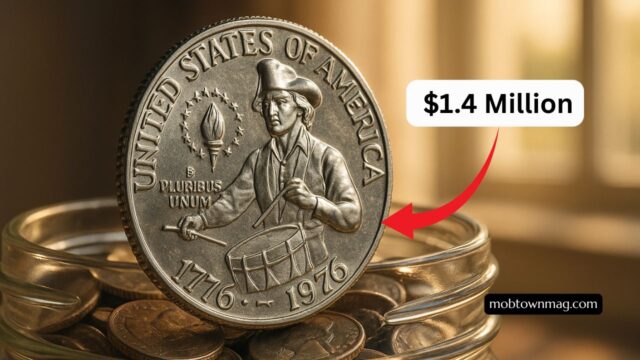The internet loves a good treasure story, but the oft-repeated claim that a 1976 Bicentennial quarter was “found in a jar” and sold for $1.4 million is not true.
Still, some Bicentennial quarters (especially high-grade pieces and certified mint errors) can bring serious money—just not anywhere near seven figures.
This guide breaks down what’s actually valuable, how to spot premium varieties, and the highest verified prices so you can separate fact from clickbait.
Quick Myth-Buster
- Myth: “A random Bicentennial quarter sold for $1.4M.”
- Reality: The top verified prices for Bicentennial quarters are generally hundreds to low five figures, depending on grade and error type. Routine coins from pocket change are almost always face value.
What Makes a Bicentennial Quarter Valuable?
Most 1776–1976 quarters are common. Value jumps when three things align:
- Grade (Condition): Superb, certified grades (MS/PR 68–70) are scarce.
- Composition/Finish: San Francisco–minted proofs (clad and 40% silver) in Deep Cameo can bring premiums.
- Mint Errors/Varieties: True errors (off-metal planchets, wrong planchet strikes, dramatic off-centers) and major doubled dies are the headline makers.
Tip: Uncirculated coins in original Bicentennial sets can be a starting point, but the big jumps require third-party certification (PCGS/NGC) and exceptional attributes.
The Highest Verified Price Types (What’s Real)
Below is a simple, reader-friendly view of authentic high-value lanes for Bicentennial quarters in 2025. Numbers are illustrative bands based on verified market behavior; actual outcomes hinge on grade, eye appeal, and auction demand.
| Type / Variety | What It Is | Typical Market Reality (2025) | Why It’s Valuable |
|---|---|---|---|
| Business-strike 1976-D at top pop | Regular Denver issue in ultra-high grade (e.g., MS66–MS68) | High hundreds to low thousands; rare pop-top pieces can reach several thousand | Population rarity at the top of the grading scale |
| 1976-S Silver Proof, Deep Cameo | 40% silver proof with frosted devices, mirror fields | Generally $100–$500 in PR70 DCAM is common; standout coins or sets can do better | Collector demand for perfect proofs |
| Major Doubled Die (e.g., FS-101) | Recognizable doubled lettering/devices | Hundreds to low thousands depending on grade/clarity | True, cataloged variety with collector following |
| Dramatic Mint Errors | Wrong planchet, off-metal, off-center, broadstrike, die cap | Four figures, sometimes into low five figures for spectacular pieces | Visual shock value + rarity |
(If you’re writing captions: show close-ups of the drummer boy reverse, cameo frost on proofs, and arrows to doubled lettering for educational value.)
How to Tell If Yours Is Special
- Check the mint mark:
- “S” = San Francisco proofs (clad or 40% silver).
- “D” = Denver; no mint mark = Philadelphia (business strikes).
- Weigh it (if you can):
- Clad quarters ≈ 5.67 g; silver-clad proof planchets differ on specialized errors.
- Look for eye-popping errors:
- Off-center strikes with missing design, wrong planchet (e.g., struck on dime or half-dollar planchet), or dramatic die caps.
- Grade matters: The difference between MS65 and MS67 can be multiples of price.
- Authenticate: Big claims need PCGS/NGC certification and, ideally, auction provenance.
Common Misinformation Traps
- “Guaranteed $1M+” headlines: Usually clickbait that never cites live auction houses.
- Random blog lists quoting billions: Ignore. No U.S. Bicentennial quarter has billions-level value.
- eBay asking prices ≠ sold prices: Always check realized prices and cert numbers.
Pricing Snapshot (Reader-Ready)
Use this as an at-a-glance table for typical outcomes collectors actually see:
| Coin / Situation | Realistic 2025 Outcome |
|---|---|
| Average worn 1776–1976 quarter from change | $0.25 |
| Nice uncirculated roll find (no major variety) | $1–$10 each, depending on luster/marks |
| 1976-S Silver Proof, PR69–PR70 DCAM | Often $100–$400+; perfect-grade sets can be higher |
| Top-pop 1976-D business strike (PCGS/NGC) | High hundreds to several thousand (pop-dependent) |
| Major, photogenic error (e.g., wrong planchet) | Commonly four figures; exceptional pieces low five figures |
Bottom line: Genuine five-figure Bicentennial quarters exist, but they’re extraordinary (spectacular errors or population-rarity top-pops). Seven-figure sales for this type are not a thing.
How to Sell (If Yours Looks Great)
- Get it certified (PCGS/NGC). Raw claims draw skepticism.
- Consider major auction houses for big pieces; they attract the right bidders.
- Keep provenance: emails, original packaging, and any expert notes.
- Manage expectations: high grades and wow-factor errors are the exception.
The $1.4 million coin-jar Bicentennial quarter story is myth, not market reality. However, genuine money is on the table for top-grade business strikes, perfect Deep Cameo proofs, and especially spectacular mint errors.
If your 1776–1976 quarter looks unusual—ultra-sharp, deeply cameoed, or obviously mis-struck—get it certified and compare against verified auction results.
That’s how you turn pocket change into real profit—and keep your readers informed with facts, not folklore.
FAQs
Are any Bicentennial quarters actually worth big money?
Yes—top-pop graded coins, major doubled dies, and dramatic mint errors can sell for thousands, sometimes low five figures. But routine coins are face value.
How do I know if mine is silver?
Only San Francisco proofs were made in 40% silver sets. If it’s a normal circulation coin from Philadelphia or Denver, it’s clad. Look for “S” and proof-style mirrors.
What’s the fastest way to get a real value?
Submit to a reputable grading service (PCGS/NGC) and check realized prices from major auction houses for the same date, variety, grade, and designation (e.g., DCAM/Cameo).
